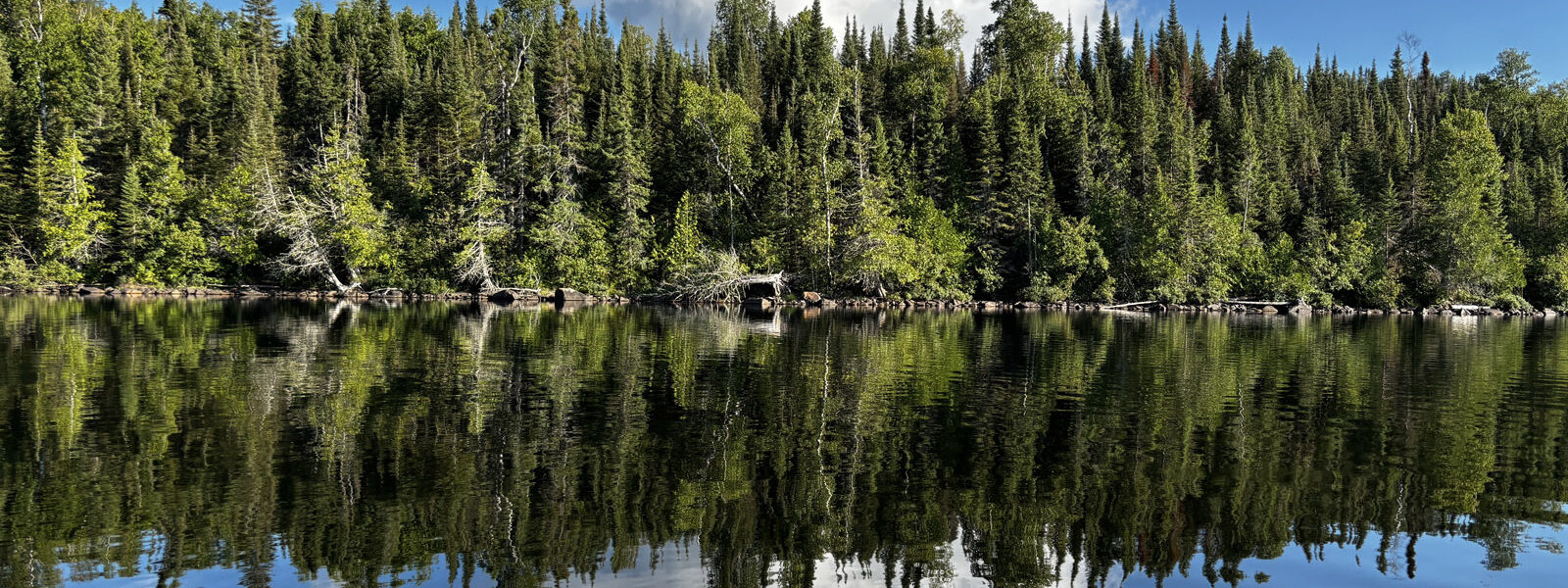Trail Time – Ahhh…September
The second week of September starts with all of nature holding her breath. There is no wind today. The clouds are piling up, higher and higher, barely moving across the wide sky between me and the blue hills of Canada.
The songbirds have grown nearly silent — their courtship days are over and there is no need to guard the nest. After all, the babies have flown. But the resident loons sing us their songs at all hours. In the middle of the night, I love hearing their solo descending wail, especially on a night like last night, with a bright moon lighting up the forest, casting moon shadows over the landscape.
This morning I heard but didn’t see a loon splashing, then softly hooting with that quiet contact sound, It was answered by an equally soft hoot further down the lake. A thick line of cedar trees formed a screen, blocking the near shore of the lake from my view. I could track the loons by their calls as they headed eastward.
On a recent evening Lars and I took the blue canoe on a little paddle — we had no goal in mind, we just needed a tootle around the lake after a day of work. Lars has been busy this summer constructing a timber frame entryway. My work (and joy) is writing stories and painting pictures. It’s not bad work if you can get it.
As we slid off the dock and into our canoe, all our work was left behind. That day I was in the stern and conditions were perfect for playing with the wind. By that I mean I was exploring different ways of finding a tack that would take minimal effort on my part and get me where I wanted to go. I was using the wind much like a sailor does, with the canoe acting as sail. As I paddled, I was thinking about the day that I had a sailing lesson from a bald eagle.
I watched the eagle fly into a boisterous wind, adjusting its wings, head, tail and direction of travel to slide along with the air currents with minimal effort. That eagle traversed the sky with barely a beat of its wings against the wind but using it. As I paddled with the wind in our blue canoe, I could feel the slight changes when the wind pushed the bow of the canoe. The bow acts as a kind of sail — it catches the air. I’m not a sailor, so I don’t have the lingo, but the partnership of paddler, canoe and wind is endlessly fascinating to me. It reminds me of riding a horse, something I used to do many years ago in another life. It feels like there is something alive in the wind and canoe. With a horse, the touch of hands on reins sends signals to and from horse and rider. In a canoe, my hand on the paddle feels the effects of the wind on the canoe and helps me shape the direction of travel. As we turned for home, the day turned golden. We canoed into the northwest gusts, at peace on the water.
Later that night, a big storm rolled through. The thunder and lightning felt menacing. It was not a gentle rainfall. This was no wind to play with. It felt like an unusually wild storm — it commanded our attention as it announced its power with thunderous rolls. The lightning lit up the sky over and over. Then the rain came hard against our metal roof. Big drops kept slamming down. It was the kind of rain where you would not want to be on the water. As we have been at times on Boundary Waters trips, and I bet many of you have, too. The power of today’s storm affected me. I felt put in my place. I was humbled.
I felt humbled again at another event earlier in the week, at the Seagull Lake Community Center, where we listened to Mark Hanson telling tales of the Northwoods. The Gunflint Trail Historical Society hosted the storytelling experience. Mark, a boatbuilder, and his wife Wendy were instrumental in starting North House Folk School. Mark regaled us with tales of his friendship with Benny Ambrose, who homesteaded on Ottertrack Lake in the early years of the twentieth century. The only way to get to his trapper’s cabin was by canoe. Mark told stories about birchbark canoes, fur trapping, lots of whiskey and wolf hunting plus some bear killing. Not for the faint of heart, for sure, but neither was life up here back then. It was such a different time. The challenges were enormous; people had to hunt, trap, fish and grow what food they could to survive. Mark told us about how Benny had carried rich Iowa soil, one Duluth pack a time, one canoe trip at a time, until he had enough for his garden.
I’m humbled by the dogged strength of people from the past who made a life up here, before paved roads, before electricity, before refrigeration.
There are challenges still, living far from town, especially in the winter. But there is one thing we still have in common with those of the past: a strong network of neighbors and friends who treasure this special place and help one another out here along the Gunflint Trail.
The Gunflint Trail Historical Society will be sponsoring several more talks this fall at Chik Wauk museum near the end of the Trail. Check it out online at https://gunflinthistory.org/
~ Marcia Roepke











